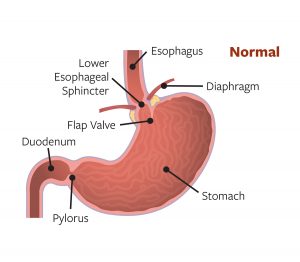
The stomach is designed to produce acid, and it contains digestive enzymes that help digest proteins, absorb vitamins and minerals. These enzymes provide protection from bad bacteria and parasites. While the stomach is designed to house these digestive juices and can protect itself, the esophagus does not have the same ability. Symptoms of gastroesophageal reflux disease (GERD) begin when stomach contents reflux up into the esophagus and cause irritation.
The body’s natural reflux barrier is a complex system, composed of:
- Lower Esophageal Sphincter. This is a bulking of esophageal muscle at the base of the esophagus. At rest, these muscles tighten to prevent stomach contents from moving into the esophagus. The lower esophageal sphincter works best when it is at least 2-3 centimeters (around one inch) long and located within the abdominal cavity.
- Crural pinch. The diaphragm is a muscle that separates your chest cavity from your abdominal cavity. The esophagus goes through a small hole in the diaphragm muscle, known as the crura, which normally pinches and bolsters the lower esophageal sphincter, and helps prevent reflux.
- Angle of His. The esophagus enters the stomach at an angle called the angle of His. This tight angle creates a sort of flap valve that allows food to pass down but aids in the prevention of reflux.
- Phrenoesophageal ligaments. These ligaments attach the diaphragm muscle to the esophagus and anchor it in place. They also act as bulking around the lower esophageal sphincter.

All of these mechanisms work together to prevent reflux. If just one component of the reflux barrier fails, then the others will likely still prevent reflux. However, as more components fail it is more likely that reflux episodes will occur. One example of this is a hiatal hernia.
In patients with a hiatal hernia, multiple components of the reflux barrier fail:
- The hole in the diaphragm that the esophagus goes through (crura) is larger than normal.
- The stomach begins to slide up into the chest and the lower esophageal sphincter (LES) is no longer bolstered by the crural pinch.
- The phrenoesophageal ligaments stretch as the stomach slides up and no longer bolster the LES.
- As the stomach slides up it is straightened and the Angle of His is no longer able to act as a flapper valve.

This is just one example of how anatomical changes can lead to failure of the reflux barrier. Your doctor will need to perform specific tests in order to determine what is causing your reflux and how best to treat it.


